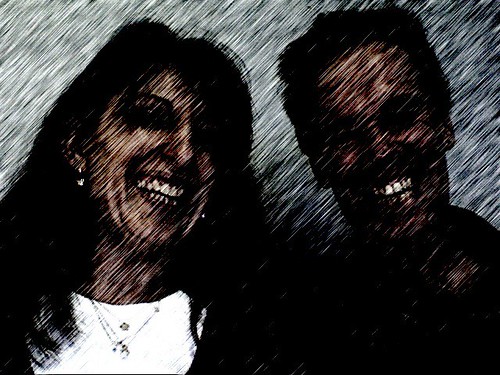Wednesday, July 16, 2008
Practices of remix are opening up avenues for young people to become and be "kinds of people" – including lots of young people who do poorly in formal education Literacies The talk begins with a definition of literacies as "socially recognized ways of generating, communicating and negotiating meaningful content as members of Discourses through the medium of encoded texts." This definition approaches text in relation to contexts and practices. The talk will focus on the Discourse aspect of "literacies", with reference to two "new" literacies that draw on new technology affordances that enable activities of kinds and/or on scales that were never before possible. Remix Michele goes on to define remix in terms of practices that involve taking cultural artifacts and combining and manipulating them into a new kind of creative blend. Nothing new about remix per se – as Lawrence Lessig reminds us in his work on Free Culture. Numerous kinds of "new" remixing practices exist that are predicated on new technology affordances. E.g., photoshopping remixes, music and music video remixes, machinima remixs, moving image remixes, original manga and anime fan art, remixes of TV, movies, books in fanfiction, and serviceware mashups (e.g., Twittervision.com). Michele works through a range of examples and some of the issues – e.g., copyright – associated with remix practices. Identity and learning Begins from Rebecca Black's definition of identity as "the ability to be recognized as a "kind of person … within a given context". The talk approaches identity as discursive and multiple and emphasizes "learning to be" rather than "learning about" (as discussed by Gee in his 2007 book); with particular references to the link between learning and identity, and to developing "appreciative systems" that come with deep learning within contexts of practices. Will be looking at two young people in terms of this framework (Rebecca Black's case study subject, Tanaka Nanako, and Michele's own case study of am AMV fan known as Dynamite Breakdown). Place and space (as theorized by Michel de Certeau in The Practice of Everyday Life) Michele describes the distinction between "place" and "space", in terms of place being a property of the powerful, and space being the fleeting "locations" from which the less powerful operate on the fly to negotiate through the places of the powerful – making do and enacting the arts of the weak; working around the strategies of the strong by practicing tactics of the weak. As Henry Jenkins has argued since the early 90s, this is a useful way for thinking about remix in terms of poaching on the resources of the powerful. Rebecca Black's case of Tanaka Nanoko Michele moves on to Rebecca Black's work, (especially her 2008 book on Adolescents and Online Fan Fiction) to discuss the case of Tanaka Nanako as a non English speaking migrant arriving in Canada from China, having to learn a new language, and finding the fanfiction.net site; picking up on the stories of migrant peers, and learning "how to be a successful fanfic practitioner". Michele is working through some key aspects of be(com)ing a proficient fanfic writer – e.g., making use of the author notes facet of writing a fic, as a means of articulating aspects of identity whilst taking on a new identity as a fanfic writer. She turns to the ways Black describes Nanako developing an appreciative system as a fanfic writer, and the dimensions of doing so. E.g.,
Draws on the rich account of her case provided by Black to discuss identity and deep learning in relation to space. Notes how Nanako shifted aspects of her presentation of self in her author notes over time – identified differently as her work became increasingly popular. No longer had to present herself as an English language learner, etc. Dynamite Breakdown (one of Michele's research cases) Michele provides a short description of Dynamite Breakdown as an "average student" with an interest in Naruto anime and developing an interest in creating anime music videos. He spent a long time developing deep knowledge of the series and wider anime, and exploring AMVs. She plays Dynamite's "Konoha Memory Book" AMV – which is DB's favourite creation, and which won awards at the 2006 Los Angeles Anime Expo. "Konoha Memory book" - DynamiteBreakdown (2006) DB's interview relates his ideas about what is involved in becoming a proficient AMV remixer.
Developing an AMV appreciative system
So what? (a) Challenges the dominance of "learning about" within pre-packaged curriculum programs and resources
(b) Challenges top-down, imposed notions of "expertise" and "effective participation" cf. ETS.org's "iSkills" test
AMV remixing cannot be described by a generic set of quality indicators or competencies; because it is so thoroughly embedded in a particular social practice that is shaped by the anime, popular music, fan practices, and the sophistication of low-cost editing software, markers of "proficiency" will always be considered contingent and "in process" rather than fixed and statically authoritative.
References
Black, R. (2008). Adolescents and Online Fan Fiction. New York: Peter Lang. Gee, J. (2007). Video Games + Good Learning. New York: Peter Lang. |
Labels: identity








